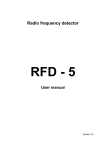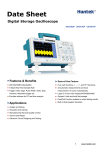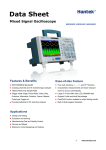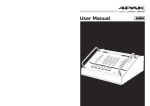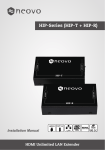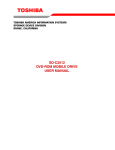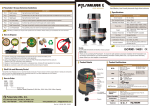Download 77KB PDF
Transcript
Radio frequency detector RFD - 22 User manual Version 1.0 User manual RFD-22 is an advanced broadband high sensitive radio frequency detector. Parameters of RFD-22 are optimized for detection of all type wireless bugs including the latest technology. RFD-22 can be used to detect digitally encoded signals, spread spectrum, hopping and pulse transmissions, and signals at extremely high frequencies up to 20GHz. Since RFD-22 is a state-of-the-art device technical and operational training is recommended. I. Controls, inputs, outputs - LED display 2 characters Main switch ON / OFF Audio alarm switch AUDIO ON / OFF Mode switch MEASURE - PROTECT LED CHARGE (charging indicator) Connector EARPHONE (earphone stereo type 8 -32 ohm) Connector EXT.POWER (external power and charge) Connector EXT.PROBE Telescope antenna II. Power ON, battery check and charging After power on the device performs a self test; LED shortly displays C7 and if AUDIO switch is ON the melody tone can be heard. After the self test the device is set to the selected mode (MEASURE or PROTECT). The RFD-22 constantly measures the battery health status. If Lb is periodically displayed followed by low frequency tone, the battery should be replaced or the accumulator should be charged. WARNING: deeply discharged battery can cause either no function or displaying C7 only. 9V battery or accumulator is below the bottom lid which can be removed by the nail to the cut in the bottom lid. Be careful when inserting the battery and closing the lid not to damage the battery wires and to set the lid properly. It is recommended to use a 9V NiMH or NiCd accumulator which can be recharged by an external power supply 12 to 20V DC with + pole on the central pin. Charging time of the fully discharged accumulator is 14 hours. Longer charging times are allowed since an internal regulation circuit avoids accumulator overcharging. 2 III. Measurement, sweeping, bug detection Adjust MEASURE mode and push out the telescope antenna. The signal level is displayed in values: 0 - 99 and A0 - C7. Example: B8 = 118. Slowly move the RFD-22 and properly check the entire room and all objects inside the swept area. The listening device is usually ingeniously disguised. A rapid increase of the RF field observed at a spot or close to an object signalizes a potential RF eavesdropping. During sweeping use the earphone (output EARPHONE) and listen to the demodulated signal. Often a bug can be heard in the earphone, but using earphones primarily helps to recognize legal signals like TV and radio broadcasting or GSM. If the AUDIO switch is ON, the Geiger click audio indicator is enabled and helps the user to find the strongest signal by increasing the click frequency with an increase of the RF signal level. Characteristics of typical signals: a) TV carrier: 50 Hz noise, usually stronger close to windows b) Broadcast: voice or music c) GSM: cell – data and tone about 2 kHz, mobile – pulses depending on talking d) Listening device: most of the RF listening devices are using analog modulation systems. Those most common devices are heard in the earphone, the room sounds are getting stronger closer to the bug and the acoustic feedback can eventually appears. e) Dangerous signals not covered by a) - d). The maximum of these signals has to be found; it is necessary to prove if the signal is originated in the swept area or if the signal is incoming from outdoor. IV. Localization of listening device Close to the transmitter there is a rapid increase of the RF field. To improve localization accuracy it is better to shorten the telescope antenna; the indicated RF LEVEL decreases, which enables a sharper detection of the signal maximum. 3 Fig.1: Ability to detect various radio listening devices Fig.2: Dependence of the indicated level on the bug distance for 0.1, 1, 10mW ERP 4 V. Sensitivity, frequency range, bug distance and power calculation The RFD-22 is a very sensitive detector with extremely large frequency range, detecting real listening devices up to 20 GHz. Fig.1 depicts the ability of RFD-22 to detect various radio listening devices for an indication RF LEVEL = 2 and the distance of 5cm from the signal source. From the graph we can observe that effective radiated power (ERP) 1uW (1000x less than typical bug is radiating) can be detected up to 10GHz. A more realistic 1mW device can be detected up to 20 GHz! Fig.2 depicts a dependence of indicated LEVEL on the DISTANCE for three typical bug output powers (ERP). Since close to the transmitter the electromagnetic field is very non-homogeneous the highest measured level is valid at the optimal position and length of the RFD-22 antenna. The plots at fig.2 are valid in the frequency range 80-500 MHz (typical bug frequencies). If the transmitter distance is known the radiated power (ERP) can be read from the graphs and consequently it is possible to deduce the theoretical range of the listening device in the real environment. VI. Permanent protection Switch the device to the PROTECT mode. The LED displays Sb (store background) followed by a number, which is an automatically adjusted alarm threshold. The threshold is always higher than the local background: its level is equal to background + 5dB. If the radio field is bug-free the LED displays Pr (protect). In case of an activation of a bug or another increase of the radio field an alarm is indicated. Instead of Pr, the LED displays a number, which represents the RF level of the alarm signal. If the AUDIO switch is ON the warning tone is enabled. The alarm indication is active as long as the RF level increases. When the radio signal disappears (e.g. the bug turns off) the display returns to Pr and in the 8 sec. period the highest alarm signal level is displayed. For example alternating PE and 54 show that the strongest alarm signal reached RF level 54. The RFD-22 detects even very short pulses (>80 us) important to detect some advanced digital systems. This speed can cause detection of different disturbances like switching electric appliances, lamps etc. To eliminate detection of electric disturbances do not use mains power supply and place the RFD-22 as far as possible from electric cables and mains connected devices. 5 Switching to MEASURE mode and back to PROTECT mode erases the PE memory and stores a new background to the background memory (Sb). Warning: No radio bug should be active during storing of the background (switching from MEASURE to PROTECT mode). Also avoid any mobile or other wireless device to be active during storing of the background. VII. Detection of pulse transmitters Ensure a permanent conversation or other sound in the checked area to force a hidden pulse transmitter to transmit as much data as possible. Set the PROTECT mode. Systematically move the RFD-22 to find the signal maximum displayed after PE. Set the AUDIO switch to ON to be acoustically informed about each signal activity. VIII. Detection of SHF frequencies 3 – 20 GHz For very high frequencies, particularly above 3 GHz the telescopic antenna loses efficiency. For SHF detection it is better to fully push the antenna into the RFD-22. The active part of RFD-22 is the front lid. The strongest level can be detected if the front lid is pointing to the source of SHF signal. IX. External probe For sweeping high ceilings or hardly reachable places connect the external probe. The probe disconnects the internal detector. RFD-22 functionality remains the same, only the frequency response is equal to the connected probe parameters. Warning! • Do not open the device, there are no elements adjustable without special equipment • Use 9V 6F22 battery or 9V NiMH or NiCd accumulator. Never use non-rechargeable alkaline batteries if the mains power supply is connected • Short click in the earphone each 9 sec. is a self calibration of the detector; it is no fault or a signal to be checked. 6 Simplified usage of RFD-22 (VIP application) VIP operative sweeping The security service specialist sweeps the office and creates a written protocol containing maximum levels measured at specific places in the VIP office. Then the VIP user checks if there is a remarkable increase of RF level comparing with originally listed values at the specified places. This check should be performed either before or better during a VIP meeting. Any level increase especially close to mobile phones (GSM) should be carefully examined. An example of a written protocol made by a specialist for VIP operative sweeping: CEO office: Antenna full length: window max. 65, desk max. 40, PC max. 50, other max. 35 If a higher RF level is detected it is recommended to use the earphone and find the signal source (a bug), or to call a specialist to provide appropriate countermeasures. VIP permanent protection Adjust the length of telescope antenna to 4 – 10 cm. Put the RFD-22 as close as possible to negotiation table. Adjust PROTECT mode. Do not use mobile phones during storing background (during switching from MEASURE to PROTECT mode)! Pr is displayed in normal status. Any number replacing Pr means a danger that a bug is activated or GSM or any other wireless device is active. Short alarms can be detected because the GSM phones are periodically checking their system connection. For acoustic warning switch ON the AUDIO to be acoustically informed about a danger. 7 Technical specification - Frequency range: 0.5MHz to 20GHz - Typical sensitivity: 0.08uW ERP (400MHz / 5 cm / level =3) - Dynamic range: 43dB - Detectable pulse width: >80us - Geiger click indication: internal buzzer - LED indicator: 2 characters - Instant signal strength indication: - numerical (127 levels) - Peak level indication: - numerical (127 levels) - Alarm memory: record of highest level - Built in telescope antenna: adjustable from 1 to 38cm - External probe: 3.5 mm mono connector - Earphone: stereo type 8 - 32ohm - Battery low indication: below 7.2 V - External power supply: 12-20V DC unstabilized - Accumulator recharge circuit: optimized for NiMH or NiCd - Battery: 9V model 6F22, or 9V accumulator - Current consumption: 8 to 10 mA - Mechanical size: 150 x 58 x 29 mm - Weight: 245g 8








